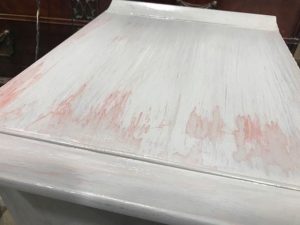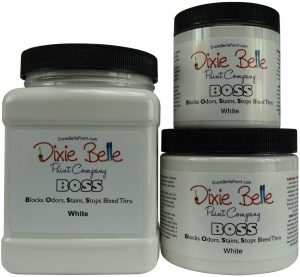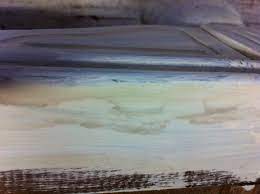Last updated on February 2nd, 2022
Several problems can arise when using chalk paint incorrectly. One of these is bleed-through. These are the blotchy ugly looking stains or yellowish-brown patches that appear after you apply your first coat or even several weeks later. Wood bleeds are the bane of any furniture makeover, and they can happen to both newbies and experienced woodworkers. When you come across the problem, it may seem like your piece is ruined; don’t worry, in this guide, we discuss how to fix chalk paint bleed through on furniture.
The simplest way to fix chalk paint bleed-through on outdoor furniture is to seal it. For this, our favorite remedy is clear shellac spray or shellac-based primer. Just apply it to the affected area and allow it to dry. After it dries, you can rub on more paint. This should prevent any further bleeding or brown spots coming through paint.
In this article, we will look at how to fix chalk paint bleed-through on wood furniture, so you will know to stop it in its tracks whenever it raises its hideous head against you.
Table of Contents
What is chalk paint bleed through on furniture?
Chalk paint bleed-through is simply a color tint (more like a stain) that peeks through chalk paint as it begins to dry. Sometimes it may not appear until after you wax or apply the finishing cream.

The color can be anything depending on the cause of the stain and the wood type.
For instance, when painted with chalk paint, mahogany will often bleed through with a slight shade of pink. On the other hand, Oak comes through the paint with a hint of yellow; white pine will often look distorted with knots in the grain. Other common colors are brown, red, and orange.
The most common causes of bleed-through are the tannins and resins in the wood.
When the wood is not properly sealed, the tannins try to escape and consequently come through on the paint. You might notice them while applying the paint, or sometimes it can take several weeks before they show up.
Besides tannins, stubborn food stains, nicotine, and many years of polishing furniture can also cause bleed-through.
Although the problem applies to all wood types, pieces made from mahogany, pine, oak, and cedar seem to be the most culprits.
How to prevent bleed-through before you start painting?
The best way to escape bleed-through in your projects is to prevent it from happening. There are a few ways to go about this, depending on your work environment and finish.
1. Test for bleed-through
Bleed-through is prevalent with old furniture and vintage. If you’re working on one of these, a good way to know whether you will encounter the problem or not is to test the piece. Of course, this has to be done before painting.
- First, wet the surface of the furniture by spraying with water or brushing with a paintbrush.
- Next, place a paper towel on the wet surface. If you don’t have a paper towel, you can sprinkle it with baking soda.
- Allow the baking soda/towel to soak up the water.
At this point, if you notice bleed-through, then it’s most likely the problem will repeat when you apply chalk paint. In this case, it’s recommended to seal the furniture before you apply paint.
2. Priming the furniture
Whether the furniture piece passes the test or not, apply a sealing primer over it before painting. For this, we recommend shellac, but any other oil-based primer will work.

We prefer shellac because it’s easy to apply (comes in a spray can) and dries quickly and clear. However, it has a terrible smell and is highly flammable; so, only use it outside. If you prefer to paint inside, then you can try a stain-blocking primer like Dixie Belle BOSS. It doesn’t have a strong smell and dries clear, just like shellac.
Always wear a face mask or respirator to protect your lungs.
Before applying shellac, make sure to prep the furniture.
- First, clean it with water and mild soap and allow it to dry.
- Then sand it lightly by hand and get rid of the dust.
- Apply at least two coats of shellac primer (we recommend three) to prevent bleed-through.
- Allow it to dry for an hour or more before you start painting. The longer you wait, the better!
3. Use a darker paint
Another way to escape wood bleeds without using a primer is to use dark paint. These paints have dark pigments that hide the bleed through so you don’t see it. This doesn’t mean the bleeding is not there – it’s just not visible.
How to fix chalk paint bleed through on furniture
Method 1: Using Shellac
The more common way to fix chalk paint bleeds is to seal the affected area with shellac. Sometimes, bleed-through can occur throughout the workpiece, so you might want to spray shellac over the whole thing. Once you apply shellac, allow it to dry. You can apply a second coat if the bleed is still visible, but most times, just one coat will be enough. After drying, paint over the shellac with your chalk paint.
NOTE: While applying shellac, pay close attention to the wood joints. These areas tend to bleed more and may require two or more coats
Method 2: Using Finishing Cream
Another way to stop bleed-through is by using a finishing cream. For this, we recommend Vintage Rocks Finishing Cream (it could be any type of finish – matte or glossy).
Make sure the chalk paint is fully dry before applying the finishing cream. As you apply the cream, focus on the areas with the color patches but make sure the coat gets to the whole piece.
If, after applying one coat, you still notice some stains or yellow patches, apply another one. Do this until it blocks the stain, then allow it to dry and apply another layer of chalk paint. You can finish off with Buzz Wax.
Finishing cream is often used in place of regular wax over chalky paint. Unlike shellac, it is water-based and non-drip, so it’s very easy to clean up.
How do you fix tannin bleeding?
The best way to avoid the stain patches left by wood tannins in chalk-painted furniture is to seal it off beforehand. Not all wood pieces will bleed, but it’s better to take steps to prevent it or be ready to get rid of it if it does occur.
Thus, to fix tannin bleeding, there are two things you can do. You either seal the furniture before you start painting, or you can spray with clear shellac if you encounter bleeding along the way. For the prevention part, you will need a shellac-based primer.
Why is my chalk paint coming off when I wax?
There are a few things that can cause your chalk paint to peel when you apply wax.

1. Incomplete curing
The major reason why paint comes off when wax is applied is incomplete curing. Even when paint seems dry to touch, it should be allowed to cure fully; otherwise, there’s a high tendency it will peel
2. Painting on a dirty furniture
Dirt can repel your chalk paint or prevent it from adhering correctly. So, before you start painting, make sure you clean the furniture properly. This can be done using a clean damp cloth. For more stubborn stains, you can use mineral spirits to wipe the piece first and follow up with water (moist cloth)
3. Painting at a low temperature
The temperature of your work area can also affect the efficacy of the paint. Specifically, low-temperature conditions can hinder the paint from adhering properly. As a general rule, don’t paint in an area where the temperature is too cold, like below 60°F).
This also applies to how you store the paint. Never store chalk paint (or any other furniture paint) under 55 degrees.
When will I most likely see chalk paint when painting?
You are more likely to see chalk paint bleed when using light-coloured paint. This is because light paints don’t hide the bleeds as well as dark paints, and the reason is obvious. You will also see bleeds if you sand down the old finish before painting. This removes any previous barrier, allowing tannins to come through more readily. Bleed-through can also occur if you’re painting on darker woods or wood with many knots. Wood knots are notorious for bleeding and should be sealed with primer before you start painting.
Conclusion.
Wood bleeds can be very annoying, especially when it concerns chalk paint. The whole idea behind opting for chalk paint is to apply it immediately and get beautiful finishes without any prep work. But the reality is that there’s always a chance of wood bleeding through paint when working with any water-based paint, including chalk paint.
Hopefully, you now know how to fix chalk paint bleed through on furniture and can confidently take on any painting job, no matter how grimey.
Let us know if you have any more questions. Till then, happy finishing!
Frequently Asked Questions.
Does stain bleed through chalk paint?
Yes. Stain bleeds through chalk paint if they are applied to older furniture. The best solution to fix this problem is to apply a knotting solution or stain blocker on top of the applied paint.
How do you fix a painted wood bleed?
If you want to get rid of bad paint bleed on wood, you should continue applying more coats of primer directly on top of the first coat.
Can you fix chalk paint bleeding on outdoor furniture?
The simplest method to fix chalk paint bleeding on outdoor furniture is through sealing. And the recommended way is by using a shellac-based primer or clear shellac spray.
What happens if you put too much wax on chalk paints?
If you put too much wax on chalk paint you’ll start to see streaks or opaque white lumps on the furniture surface.


